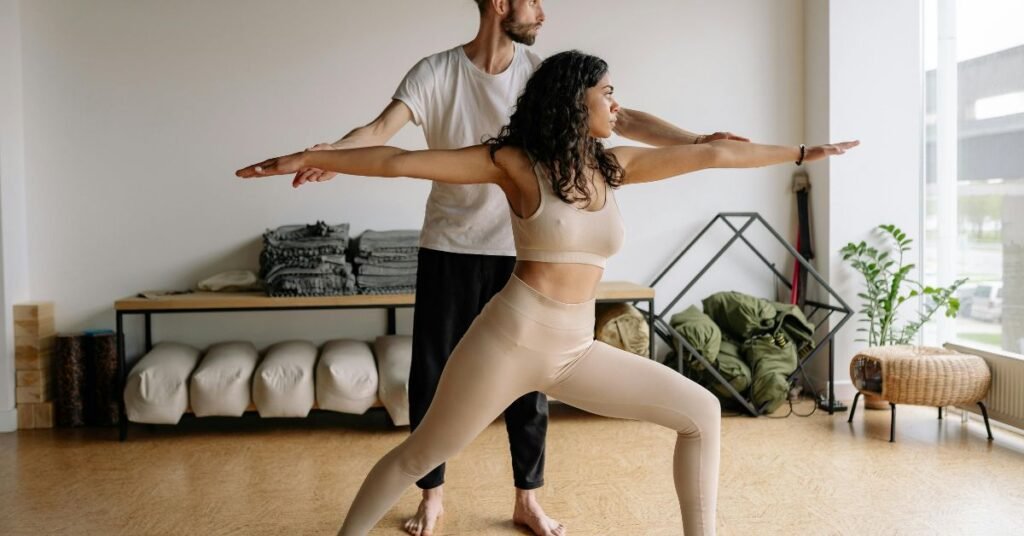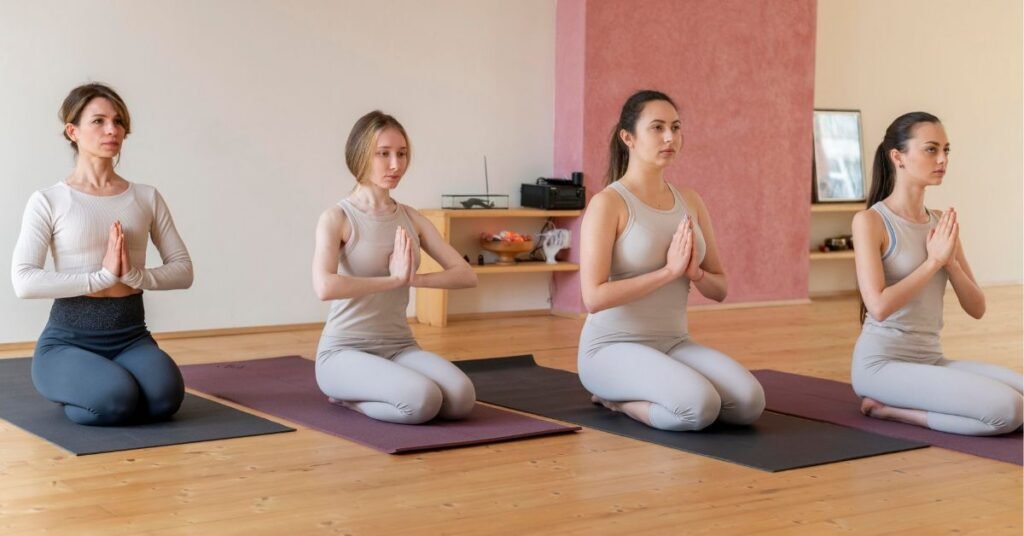Introduction
Sitting for long hours, staring at screens, dealing with deadlines—sound familiar? If you’re an IT professional, you probably spend most of your day glued to a chair, tapping away at your keyboard, with little time to focus on your health. Over time, this sedentary lifestyle can lead to back pain, stiff joints, eye strain, stress, and even burnout.
But what if there was a simple, effective way to boost your energy, improve your posture, and enhance your overall well-being? Enter yoga. Yoga isn’t just about stretching or fancy poses—it’s a powerful practice that can help IT professionals stay healthy, focused, and stress-free.
In this blog, we’ll explore why yoga is essential for IT professionals, its benefits, and simple yoga poses you can do right at your desk. Let’s get started!
Why IT Professionals Need Yoga
1. Combat Sedentary Lifestyle Issues
Sitting for extended periods can lead to poor posture, back pain, neck stiffness, and even serious conditions like obesity or heart disease. Yoga helps counteract these effects by improving flexibility and strengthening muscles.
2. Reduce Stress and Anxiety
Deadlines, long hours, and constant problem-solving can take a toll on your mental health. Yoga incorporates deep breathing and mindfulness techniques that help reduce stress and improve mental clarity.
3. Improve Focus and Productivity
Yoga encourages better blood circulation to the brain, which can enhance concentration, memory, and cognitive function—critical skills for any IT professional.
4. Enhance Posture and Reduce Pain
Poor posture is a common problem among IT professionals. Slouching over a desk can cause chronic pain in the neck, shoulders, and back. Yoga helps by improving posture and relieving tension in these areas.
5. Boost Energy Levels
Feeling sluggish by midday? Yoga stimulates blood flow, oxygenates your body, and releases endorphins, giving you a natural energy boost without relying on caffeine.
6. Improve Sleep Quality
A restless mind and body can lead to poor sleep. Yoga relaxes the nervous system, helping you fall asleep faster and enjoy deeper rest.
Readmore: Yoga for Depression: How It Helps
Readmore: The Best Yoga Poses for Your Dosha Type
Simple Yoga Poses for IT Professionals
You don’t need a yoga mat or much space to practice these poses. These simple exercises can be done at your desk or during a quick break to refresh your body and mind.
1. Seated Spinal Twist (Ardha Matsyendrasana)
Benefits: Relieves tension in the spine, improves flexibility, and aids digestion.
How to do it:
- Sit upright in your chair with your feet flat on the floor.
- Place your right hand on the backrest of your chair and your left hand on your right knee.
- Inhale, lengthen your spine and exhale as you twist your torso to the right.
- Hold for 5–10 breaths, then switch sides.
2. Desk Shoulder Opener
Benefits: Relieves shoulder tension and improves posture.
How to do it:
- Stand a few feet away from your desk.
- Place your hands on the desk and slowly lower your chest, keeping your arms straight.
- Hold for 10–15 seconds while breathing deeply.
3. Neck Stretch
Benefits: Relieves neck stiffness caused by prolonged screen time.
How to do it:
- Sit upright and gently drop your right ear toward your right shoulder.
- Hold for 10 seconds and switch sides.
- Repeat twice on each side.
4. Wrist and Finger Stretch
Benefits: Prevents carpal tunnel syndrome and relieves wrist tension from typing.
How to do it:
- Extend your right arm forward, palm facing up.
- Use your left hand to gently pull your fingers down toward the ground.
- Hold for 10 seconds and switch hands.
5. Chair Cat-Cow Stretch
Benefits: Improves spinal flexibility and reduces back pain.
How to do it:
- Sit on your chair with your feet flat on the floor.
- Inhale, arch your back and lift your chest (Cow Pose).
- Exhale, round your back, and tuck your chin to your chest (Cat Pose).
- Repeat for 5–10 breaths.
6. Standing Forward Bend (Uttanasana)
Benefits: Stretches the back, and hamstrings, and relieves stress.
How to do it:
- Stand with feet hip-width apart.
- Hinge at your hips and fold forward, letting your hands touch the floor (or your shins if you’re not flexible).
- Hold for 20 seconds and slowly come back up.
Readmore: Seated Forward Bend Pose (Paschimottanasana)
Readmore: Stargazer Yoga Pose: Step-by-Step
Mindfulness and Breathing Techniques for IT Professionals
Apart from physical postures, yoga also includes breathing techniques (Pranayama) that help calm the mind and improve focus.
1. Deep Belly Breathing
- Sit comfortably with a straight spine.
- Place one hand on your belly and the other on your chest.
- Inhale deeply through your nose, allowing your belly to expand.
- Exhale slowly through your nose.
- Repeat for 10 breaths.
2. Alternate Nostril Breathing (Nadi Shodhana)
- Sit comfortably and use your right thumb to close your right nostril.
- Inhale deeply through your left nostril.
- Close your left nostril with your right ring finger and exhale through your right nostril.
- Repeat for 5 minutes.
Tips for Incorporating Yoga into Your Daily Routine
- Start small: Even 5–10 minutes of yoga can make a difference.
- Set reminders: Use phone alerts to take yoga breaks.
- Stretch during meetings: Use long meetings as an opportunity to practice simple stretches.
- Use ergonomic furniture: A good chair and desk setup can help maintain posture.
- Join a virtual yoga class: There are many online yoga classes designed for professionals.
FAQs
Q1. Can I practice yoga if I have never done it before?
Yes! Yoga is for everyone, regardless of experience. Start with simple poses and breathing exercises.
Q2. How long should I practice yoga daily?
Even 5–10 minutes can be beneficial. If you have more time, aim for 20–30 minutes.
Q3. Do I need a yoga mat for office yoga?
No, most of the exercises in this guide can be done right at your desk without a mat.
Q4. Will yoga help with my back pain?
Yes! Yoga improves posture and flexibility, which can relieve back pain caused by prolonged sitting.
Q5. Can yoga improve my productivity at work?
Absolutely. Yoga helps reduce stress, enhance focus, and boost energy, making you more productive.
Readmore: Perfect Your Staff Pose
Readmore: Mastering the Bird of Paradise Yoga Pose
Conclusion
As an IT professional, taking care of your body and mind is crucial for long-term health and productivity. Yoga offers a simple yet powerful way to combat the negative effects of a sedentary lifestyle, reduce stress, and boost focus. The best part? You don’t need a gym or extra time—just a few minutes of mindful movement and breathing can make a huge difference.
So, why not roll your shoulders, take a deep breath, and try a quick yoga stretch right now? Your body (and mind) will thank you!

Sonu is a passionate yoga teacher with over 6+ years of experience helping individuals find balance, strength, and inner peace through the transformative power of yoga. As the creator of Pure Yoga Vibes, Sonu shares expert insights, inspiring practices, and a wealth of knowledge to support your wellness journey. Dedicated to creating a space for growth and mindfulness, Sonu’s mission is to make yoga accessible and enjoyable for everyone. For inquiries or collaborations, feel free to reach out at contact@pureyogavibes.com.



